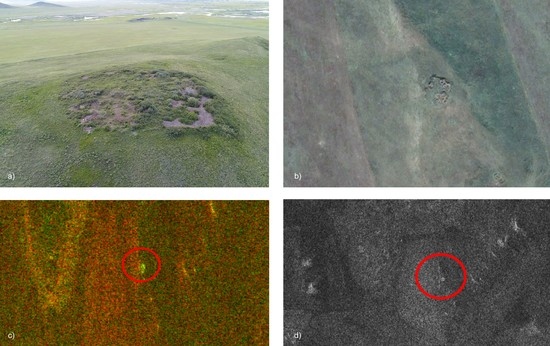Deciphering Circular Anthropogenic Anomalies in PALSAR Data—Using L-Band SAR for Analyzing Archaeological Features on the Steppe
Abstract
:1. Introduction
2. Materials and Methods
3. Results
3.1. True Positives (Archaeological Sites)
3.1.1. Finding Known “Royal” Burial Mounds
3.1.2. A Previously Unknown Archaeological Site
3.2. False Positives
3.2.1. Hilltops
3.2.2. Farms
3.2.3. Quarries
3.2.4. Modern Cemeteries
4. Discussion
5. Conclusions
Author Contributions
Funding
Conflicts of Interest
References
- Tapete, D.; Cigna, F. COSMO-SkyMed SAR for detection and monitoring of archaeological and cultural heritage sites. Remote Sens. 2019, 11, 1326. [Google Scholar] [CrossRef] [Green Version]
- Tapete, D.; Cigna, F. SAR for Landscape Archaeology; Springer: Cham, Switzerland, 2017; pp. 101–116. [Google Scholar]
- Erasmi, S.; Rosenbauer, R.; Buchbach, R.; Busche, T.; Rutishauser, S. Evaluating the quality and accuracy of TanDEM-X digital elevation models at archaeological sites in the Cilician Plain, Turkey. Remote Sens. 2014, 6, 9475–9493. [Google Scholar] [CrossRef] [Green Version]
- Chen, F.; Masini, N.; Yang, R.; Milillo, P.; Feng, D.; Lasaponara, R. A space view of radar archaeological marks: First applications of COSMO-SkyMed X-band data. Remote Sens. 2015, 7, 24–50. [Google Scholar] [CrossRef] [Green Version]
- Linck, R.; Busche, T.; Buckreuss, S.; Fassbinder, J.W.E.; Seren, S. Possibilities of archaeological prospection by high-resolution X-band satellite radar–a case study from Syria. Archaeol. Prospect. 2013, 20, 97–108. [Google Scholar] [CrossRef]
- Caspari, G.; Plets, G.; Balz, T.; Fu, B. Landscape archaeology in the Chinese Altai Mountains–Survey of the Heiliutan Basin. Archaeol. Res. Asia 2017, 10, 48–53. [Google Scholar] [CrossRef]
- Tapete, D.; Cigna, F. Trends and perspectives of space-borne SAR remote sensing for archaeological landscape and cultural heritage applications. J. Archaeol. Sci. Rep. 2017, 14, 716–726. [Google Scholar] [CrossRef] [Green Version]
- Tapete, D.; Cigna, F.; Donoghue, D.N. ‘Looting marks’ in space-borne SAR imagery: Measuring rates of archaeological looting in Apamea (Syria) with TerraSAR-X Staring Spotlight. Remote Sens. Environ. 2016, 178, 42–58. [Google Scholar] [CrossRef] [Green Version]
- Cigna, F.; Tapete, D.; Lasaponara, R.; Masini, N. Amplitude change detection with ENVISAT ASAR to image the cultural landscape of the Nasca Region, Peru. Archaeol. Prospect. 2013, 20, 117–131. [Google Scholar] [CrossRef]
- Lasaponara, R.; Yang, R.; Chen, F.; Li, X.; Masini, N. Corona satellite pictures for archaeological studies: A review and application to the lost Forbidden City of the Han–Wei Dynasties. Surv. Geophys. 2018, 39, 1303–1322. [Google Scholar] [CrossRef]
- Casana, J.; Cothren, J. The CORONA atlas project: Orthorectification of CORONA satellite imagery and regional-scale archaeological exploration in the Near East. In Mapping Archaeological Landscapes from Space; Springer: New York, NY, USA, 2013; pp. 33–43. [Google Scholar]
- Adams, R.E.; Brown, W.E.; Culbert, T.P. Radar mapping, archeology, and ancient Maya land use. Science 1981, 213, 1457–1468. [Google Scholar] [CrossRef] [PubMed]
- Elachi, C.; Roth, L.E.; Schaber, G.G. Spaceborne radar subsurface imaging in hyperarid regions. IEEE Trans. Geosci. Remote Sens. 1984, 4, 383–388. [Google Scholar] [CrossRef]
- Caspari, G. Mapping and Damage Assessment of “Royal” Burial Mounds in the Siberian Valley of the Kings. Remote Sens. 2020, 12, 773. [Google Scholar] [CrossRef] [Green Version]
- Gryaznov, M.P. Arzhan: Tsarskii Kurgan Ranneskifskogo Vremeni (Arzhan: A Royal Barrow of Early Scythian Time); Nauka: Leningrad, Russia, 1980. [Google Scholar]
- Caspari, G.; Sadykov, T.; Blochin, J.; Hajdas, I. Tunnug 1 (Arzhan 0)–an early Scythian kurgan in Tuva Republic, Russia. Archaeol. Res. Asia 2018, 15, 82–87. [Google Scholar] [CrossRef]
- Caspari, G.; Sadykov, T.; Blochin, J.; Buess, M.; Nieberle, M.; Balz, T. Integrating remote sensing and geophysics for exploring early nomadic funerary architecture in the “siberian valley of the kings”. Sensors 2019, 19, 3074. [Google Scholar] [CrossRef] [PubMed] [Green Version]
- Caspari, G.; Sadykov, T.; Blochin, J.; Bolliger, M.; Szidat, S. New Evidence for a Bronze Age Date of Chariot Depictions in the Eurasian Steppes. Aust. Rock Art Res. Assoc. 2020, 37, 1–6. [Google Scholar]
- Chugunov, K.; Parzinger, H.; Nagler, A. Der skythenzeitliche Fürstenkurgan Aržan 2 in Tuva: Archäologie in Eurasien 26. Steppenvölker Eurasiens 3; Philipp von Zabern: Mainz, Germany, 2010. [Google Scholar]
- Rukavishnikova, I.; Gladchenkov, A. Studies of Arzhan-5 in the Turan-Uyuk Basin. KSIA 2016, 243, 49–58. [Google Scholar]
- Arzhannikov, S.G.; Braucher, R.; Jolivet, M.; Arzhannikova, A.V.; Vassallo, R.; Chauvet, A.; Chauvet, F. History of late Pleistocene glaciations in the central Sayan-Tuva Upland (southern Siberia). Quat. Sci. Rev. 2012, 49, 16–32. [Google Scholar] [CrossRef]
- Balz, T.; Caspari, G.; Fu, B.; Liao, M. Discernibility of Burial Mounds in High-Resolution X-Band SAR Images for Archaeological Prospections in the Altai Mountains. Remote Sens. 2016, 8, 817. [Google Scholar] [CrossRef] [Green Version]
- Caspari, G. Quantifying the Funerary Ritual Activity of the Late Prehistoric Southern Kanas Region (Xinjiang, China). Asian Perspect. 2020, 59, 2. [Google Scholar]
- Iribe, K.; Sato, M. Analysis of polarization orientation angle shifts by artificial structures. IEEE Trans. Geosci. Remote Sens. 2007, 45, 3417–3425. [Google Scholar] [CrossRef]












© 2020 by the authors. Licensee MDPI, Basel, Switzerland. This article is an open access article distributed under the terms and conditions of the Creative Commons Attribution (CC BY) license (http://creativecommons.org/licenses/by/4.0/).
Share and Cite
Caspari, G.; Blochin, J.; Sadykov, T.; Balz, T. Deciphering Circular Anthropogenic Anomalies in PALSAR Data—Using L-Band SAR for Analyzing Archaeological Features on the Steppe. Remote Sens. 2020, 12, 1076. https://0-doi-org.brum.beds.ac.uk/10.3390/rs12071076
Caspari G, Blochin J, Sadykov T, Balz T. Deciphering Circular Anthropogenic Anomalies in PALSAR Data—Using L-Band SAR for Analyzing Archaeological Features on the Steppe. Remote Sensing. 2020; 12(7):1076. https://0-doi-org.brum.beds.ac.uk/10.3390/rs12071076
Chicago/Turabian StyleCaspari, Gino, Jegor Blochin, Timur Sadykov, and Timo Balz. 2020. "Deciphering Circular Anthropogenic Anomalies in PALSAR Data—Using L-Band SAR for Analyzing Archaeological Features on the Steppe" Remote Sensing 12, no. 7: 1076. https://0-doi-org.brum.beds.ac.uk/10.3390/rs12071076






